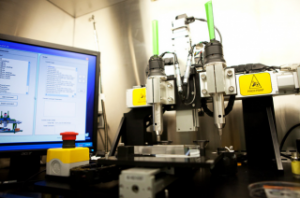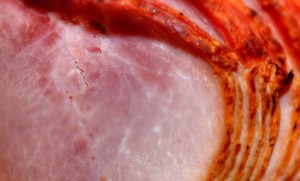3d Printed Meat
Will the new year bring in 3d printed meat? Earlier this year, billionaire Peter Theils invested a six figure sum in Modern Meadows, a company developing technology to create synthetic meats and leather. The company has a grant from the US government to research creating meat through a bio-printer.
How does bio-printing work? Much like a normal 3d printer, layers of print medium are put down one on top of another, growing the print slowly from the bottom up. Normally a scaffolding material is used to surround and hold up a biological medium. The biological medium, or bio-ink, can be tissues, fats, muscle, or any kind of cellular material. Once the whole object is printed, the scaffolding is removed, usually through treatment with electricity or liquids that dissolve the scaffolding. If done correctly, the bio-ink tissue fuses together, making the final product all one piece.
The current rounds of experiments Modern Meadows is doing with 3d printed meat uses a mixture of cell types to avoid having to use scaffolding. Instead the fatty tissue, muscle tissue, and any other types of cells bind together and hold their shape naturally. Because the meat is intended to be eaten instead of transplanted, they don’t worry about aligning veins correctly for blood flow. They expect to make all tests with pork cells using the NovoGen MMX bioprinter.

Is 3d printed meat more effective than growing “vat meat”? The promise of vat, or in-vitro meat involves growing meat through nutrient cultures, seeding a sheet with muscle cells and coercing them to grow into full sized tissues. Raising animals to use as meat sources requires a huge amount of energy. The energy invested is as growing feed, transportation to slaughterhouses, and distribution. Both 3d printed meat and cultured meat eliminate the feed and transportation pieces of the energy equation. Likely, cultured meats are more cost effective because of printing overhead. It’s possible that cultured meats would be used as inputs to the 3d printed meats, if a 3d printed meat can control marbling and give the perfect blend of fats and meat tissues. The next kobe beef might be a 3d printed, cultured beef.
Would people that are vegetarian because of ethical reasons eat 3d printed meat? They could be sure no animal with a brain suffered to produce it. Modern Meadows thinks so, but consumers that are ethically against eating meat would likely be advocates for the locavore movement, eating more natural foods. 3d printed meat is fairly unnatural. Instead, a more interesting option would be to produce meats from species otherwise unavailable. Mass produce kangaroo, shark, blue whale, panther, panda, tiger, elephant, and other wild or endangered animals. Because culturing can be started with only a small amount of tissue, the meat could be made without killing any animal.
Expected to announce results next month, the goal is to make a 2 x 1 x 0.5 cm piece of meat, essentially a tiny bite. But if successful, it will be the first bite anyone’s eaten of a 3d printed slice of meat.
